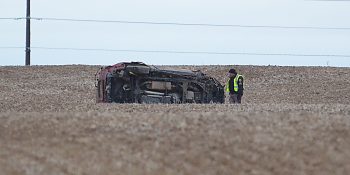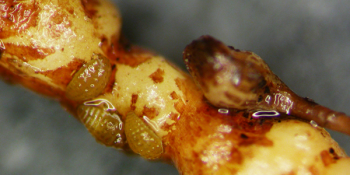Dr. Michael Bartolo is the best sort of person, accomplished yet humble. Since 1992, he has patiently bred chile peppers to find varieties that are popular with buyers and profitable for growers. In 2005, Arkansas Valley growers first planted “Mosco”, a Pueblo chile type. Today, Mosco is one of the most popular chiles grown in and around Pueblo, Colo.
That is not an easy accomplishment, given that Arkansas Valley residents are serious about their chiles. The region’s largest city, Pueblo, Colo., hosts one of the largest food festivals in the state. The Pueblo Chile and Frijole Festival, held annually in September, draws in over 130,000 visitors. The main attraction is the ever-popular Pueblo (a.k.a. Mira Sol) Chile.
Bartolo, who is the vegetable crop specialist and manager of Colorado State University’s Arkansas Valley Research Center in Rocky Ford, Colo., was born and raised on a small farm east of Pueblo. He received his undergraduate and master’s degrees at Colorado State University, and in 1990, he received a Ph.D. in plant physiology from the University of Minnesota.
In 2014, he joined with other growers and allied industries to serve on the organizing board of directors for the Colorado Fruit & Vegetable Growers Association (CFVGA). He continues to serve as a CFVGA board member.
According to Bartolo, the Pueblo Chile has been cultivated in southern Colorado for over 100 years. “It is characterized by the upright growth habit of the pepper,” he said. “Hence the name Mira Sol, which translates into looking at the sun.”
The Pueblo Chile originated in Mexico and was brought into the United States and improved by horticulturalist Fabian Garcia, a researcher at what is now New Mexico State University. From there, the pepper made its way into southern Colorado.
Bartolo’s chile breeding legacy started officially in 1992 when he obtained a strain of Pueblo Chile from his uncle, Harry Mosco, a farmer on the Saint Charles Mesa, east of Pueblo. Today, the Mosco variety has become the predominant Pueblo Chile variety in and around Pueblo.
The researcher’s matter-of-fact modesty makes it sound as though development of the Mosco variety was a small project on the side with which he was fortunate to associate. In fact, it was a project “on the side,” as Bartolo’s primary work is researching production and irrigation practices. But, development of the chile took a lot of time and many hours of work over two-plus decades.
Breeding the Mosco Chile was low tech, explains Bartolo. “If I were breeding for a seed company, it would be in a controlled environment in a greenhouse with precise pollination between plants and multiple crops each year.”
Bartolo’s chile plants grow in the open. “Chiles cross-pollinate, and insects can carry pollen from long distances, providing potential for some unusual varieties.”
“In 1994, I found a superior plant and saved its seeds. I continued to use the single plant selection process to develop more uniformity within the desired traits,” he said. “I asked a few growers and family members to try the seeds and took their feedback to adjust my selections in future years.”
In addition to taste and hardiness, Bartolo’s input from growers steered him toward plants that yielded fruit that was easy to pick and which had thick, “meaty” flesh, ideal for roasting.
“Mosco has thick fruit walls and high yield potential relative to the original forms of the Pueblo Chile,” he said. “This variety also has excellent roasting and eating characteristics.”
The Mosco Chile is more pungent than a typical Anaheim-type pepper, yet less “hot” than a jalapeño. Its estimated pungency is 5,000-6,000 Scoville units. The Mosco Chile is green and turns red as it further matures. It is Bartolo’s opinion that the red Mosco Chile is a bit sweeter with a subtler heat.
Bartolo’s chile breeding program is recognized for its importance to the chile industry by Pueblo growers.
“Mike Bartolo’s work to breed peppers that are both suited for cultivation in southern Colorado and sought after by consumers is invaluable to chile growers,” said Dominic DiSanti, a fifth generation chile grower from Pueblo, Colo., and a fellow CFVGA board member. “Growers are grateful to work with someone who understands real world production issues and offers so much knowledge and experience in specialty crops. The results of his two and a half decades of pepper development and research have helped our production tremendously and yielded superior varieties.
Neither Bartolo nor DiSanti, both of Italian heritage, find irony in their passion for developing and growing chiles most often associated with Mexican cuisine.
The Arkansas Valley is a melding of cultures and the foods that represent these cultures,” said Bartolo. “Growing up, we used chiles in our sausages, and we often had roasted chiles with many of our traditional meals
Arkansas Valley chile growers took their passion for chile a step further by launching the Pueblo Chile brand in 2015.
“They had been talking about this (branding the Pueblo Chile) for years,” said Bartolo, who suggested growers look into getting a Specialty Crops Block Grant administered by the Colorado Department of Agriculture. “The growers got the grant as well as a lot of support from the Pueblo Chamber of Commerce and Pueblo County government to promote Pueblo Chiles. A lot of folks were involved.”
Although development of the Mosco variety is a major accomplishment for a ‘side project,’ Bartolo continues to breed chiles. “We are making additional selections that will result in other varieties developed specifically for Colorado growing conditions,” he said.
Bartolo’s chile breeding project as well as irrigation and production research conducted by the Arkansas Valley Research Center will be the focus of his presentations at both the Colorado Farm Show Produce Day, Jan. 24, at Island Grove Park in Greeley and the CFVGA Third Annual Conference, Feb. 21, at the Renaissance Denver Stapleton Hotel in Denver.





